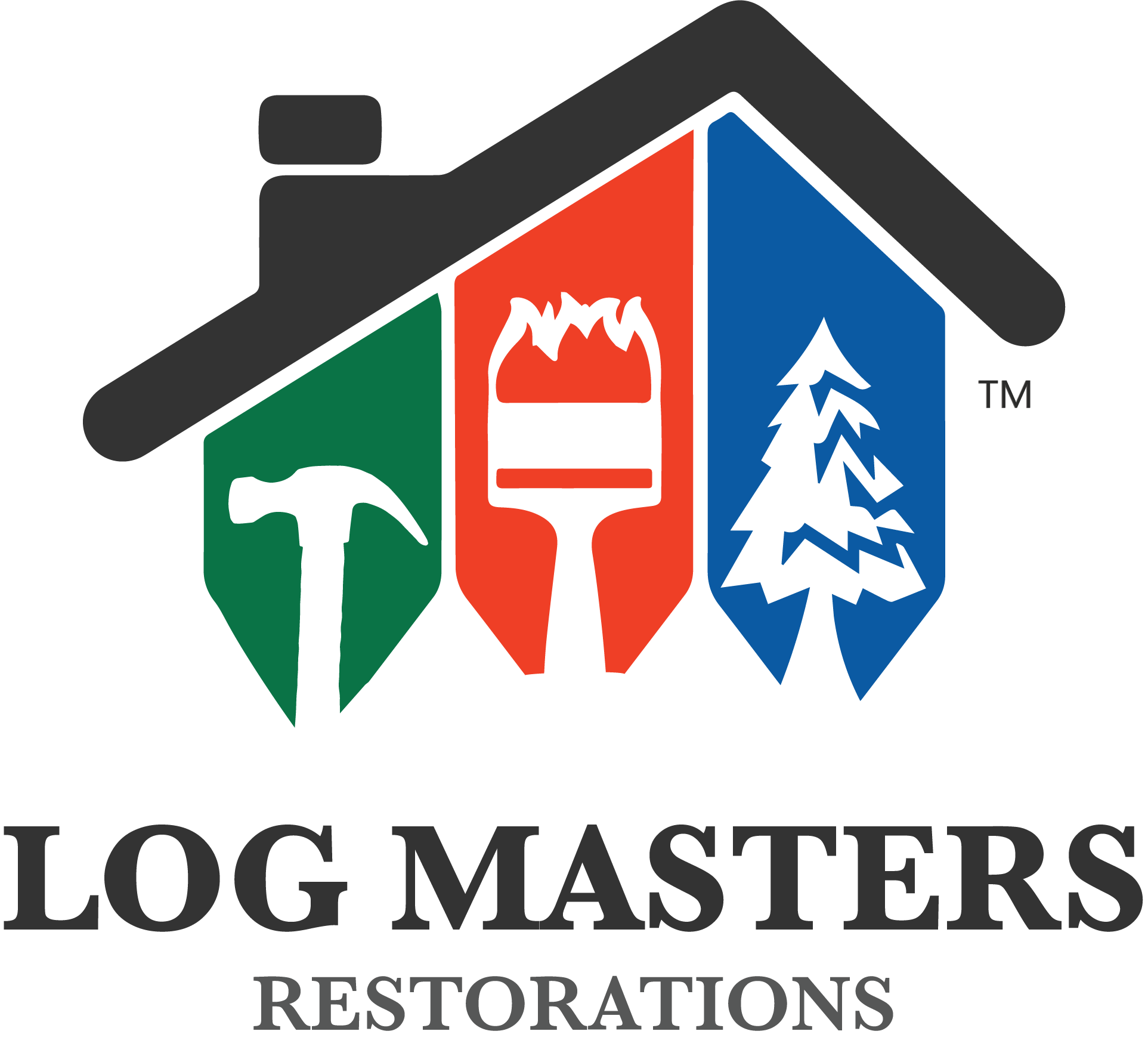Have you ever wondered what you should be doing to maintain your log home? Or are you looking for a guide to help you decide when to hire a log home restoration company to provide log home maintenance? Either way, Log Masters has the answers! After repairing and restoring log cabins for decades, we have learned the ins and outs of log cabin care.
Quick Log Home Maintenance Checklist
Before requesting a restoration estimate, we recommend all log homeowners inspect their log home for the following. Throughout the post, we will explore how to perform this maintenance checklist in depth.
- Rot or Decay: Soft spots, discoloration, or spongy wood on logs
- Cracks and Checks: Large or upward-facing cracks that may collect water
- Fading or Staining: Worn or discolored log finishes
- Sealant Issues: Gaps in chinking or deteriorating caulking around doors and windows
- Moisture Concerns: Poor roof overhangs, clogged gutters, or improper drainage
- Insect Damage: Holes, sawdust, or signs of carpenter bees or other pests
- Overgrown Landscaping: Vegetation or trees touching the logs, trapping moisture
- Foundation Grading: Ensure water flows away from your home
Step 1: Please Check for Log Rot
Log rot is a type of decay that occurs when fungi feed on wood. To check for log rot, use a steak skewer (or paint roller stick on a pole for high areas) to poke the logs. Solid logs are safe, but soft logs where the skewer sinks in are not. Note exactly where and how far into the log the skewer goes, then test these same logs to listen for hollow sounds when knocking the side of the log with a hammer. Hollow logs can also be an indicator of log rot.
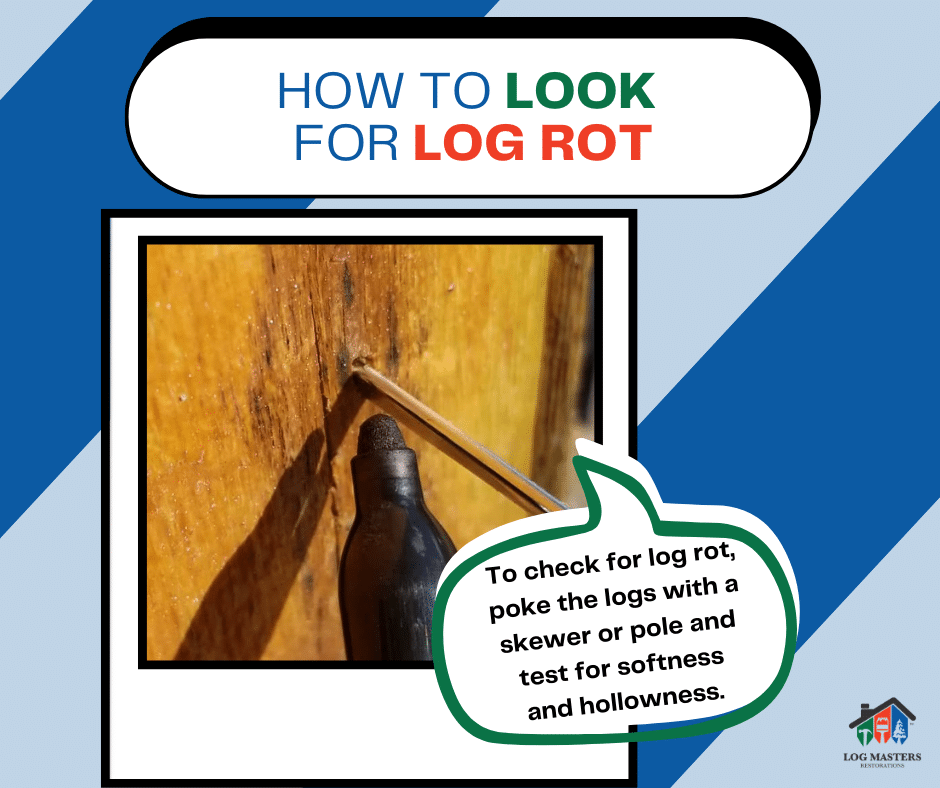
Log rot can appear anywhere on log homes. That being said, we highly recommend all homeowners check the following areas that are more susceptible to log rot:
- Area surrounding your window and door frames
- Logs near the ground (especially if the log height above the ground is below a foot)
- Areas that regularly receive shade
- Logs around your downspouts
- Posts or columns on the front or back porches
- All walls (west and south-facing walls get the most rain, while east and north-facing walls can struggle to dry out)
- Decks and porches
Take notes and photograph any possible signs of log rot you discover. When you submit your estimate request, you can share these images and notes with us.
Step 2: Inspect for Cracks and Checks
Cracks, also known as checks, naturally occur as logs age and dry. However, larger or upward-facing cracks can trap water, leading to potential decay. Use a flashlight to inspect your logs for cracks closely.
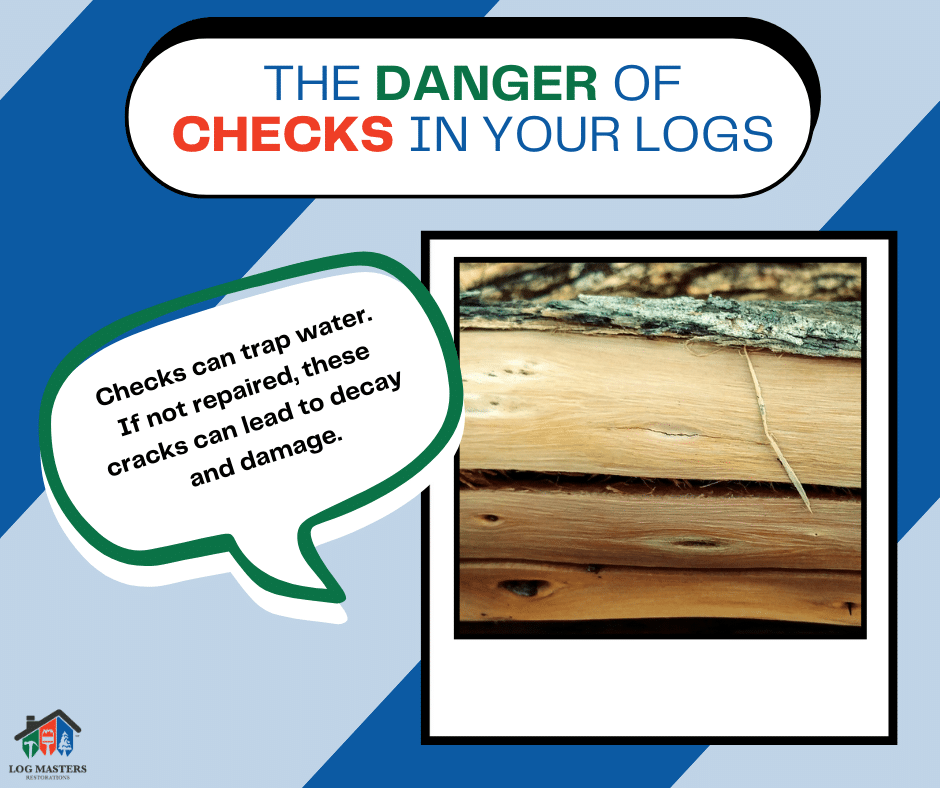
As you inspect, make note of any cracks wider than 1/4 inch or deep enough to hold water. Also, pay special attention to cracks facing upward, as they are more likely to collect moisture.
When looking for cracks, focus your inspection on these areas:
- Logs around windows and doors
- The tops of logs on horizontal surfaces, like railings or porch beams
- Areas exposed to consistent rainfall or snow accumulation
Take photos and measurements of any significant cracks to include with your restoration estimate request.
Step 3: Assess for Fading or Stain Failure
The finish on your logs protects the wood from UV rays and moisture. Over time, both oil and water-based log home stains can wear away, leading to discoloration or staining.
To evaluate your logs, look for uneven color, dullness, or areas where water no longer beads up (a sign the finish is failing). Then, check for dark streaks or spots, which may indicate moisture penetration.
As you assess fading and stain issues, pay close attention to:
- Walls exposed to direct sunlight, especially south- and west-facing sides
- Logs beneath eaves or overhangs with insufficient coverage
- Areas near sprinklers or splashback from rain
Document areas of fading or staining with photos so our restoration professionals can recommend the appropriate treatment.
Step 4: Examine Sealants and Caulking
Sealants, including chinking and caulking, protect your log home from air and water infiltration.
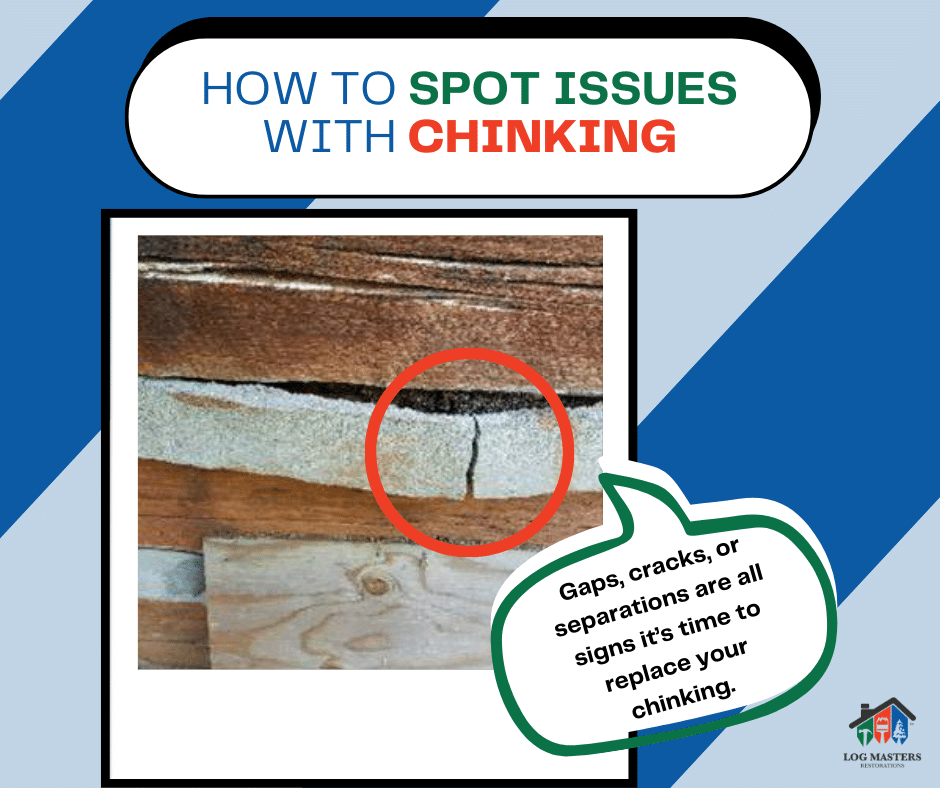
During your inspection:
- Look for gaps, cracks, or separations in the chinking between logs.
- Check caulking around windows, doors, and other seams for signs of wear or detachment.
- Pay close attention to corners where chinking may pull away.
- Also, examine window and door frames where caulking might crack.
If you notice any sealant failures, document them with photos and a brief description for your estimate request.
Step 5: Check Moisture and Drainage
Excess moisture is a primary cause of log home issues. To ensure proper moisture control, you should regularly inspect roof overhangs, gutters, and downspouts to ensure all are working properly to direct water away from your log home. Please take photos of any drainage concerns, such as pooling water or clogged gutters, as these can be clear signs your log home requires maintenance.
Step 6: Look for Insect Damage
Insects like carpenter bees, termites, and wood-boring beetles can damage your log home by tunneling into the wood. Knowing what to look for can help you spot problems early.
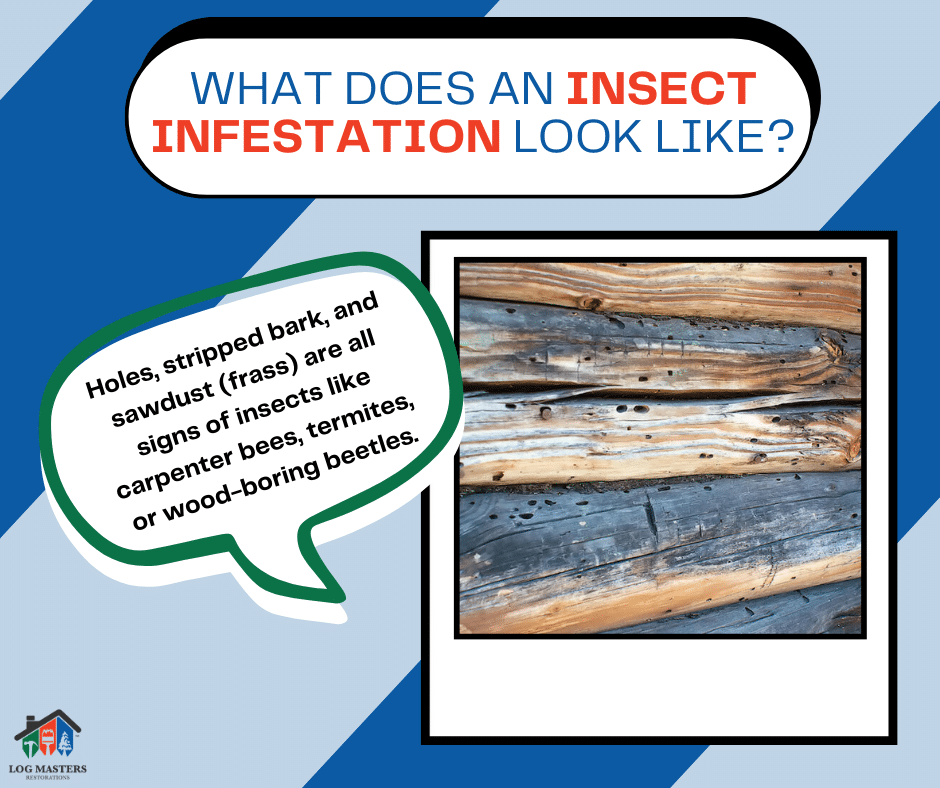
During your inspection, check for the following signs of insect activity:
Small Round Holes
Carpenter bees drill perfectly round holes, typically 1/2 inch in diameter, on the undersides of logs, eaves, or porch beams. Powderpost beetles may leave smaller, pin-sized exit holes.
Sawdust or Frass
Look for piles of fine sawdust (called frass) beneath holes or along logs, which is a sign of carpenter bee or beetle activity.
Mud Tubes
Termites build small, pencil-sized mud tubes along the foundation or wood surfaces to stay protected while traveling.
Tunnels or Galleries in the Wood
Check for visible tunnels inside logs, especially if you notice soft or hollow areas. This is often a sign of termite or beetle damage.
Woodpecker Damage
Unusual damage to your logs, such as holes or stripped bark, might indicate woodpeckers hunting for insects within the wood.
Active Insects or Nests
Spot live carpenter bees hovering near eaves or logs. Look for insect nests in corners, under porch ceilings, or near downspouts.
Step 7: Review Landscaping Concerns
Proper landscaping plays a vital role in protecting your log home. To ensure your landscaping isn’t causing issues, look for vegetation, like shrubs or trees, that is too close to the logs and trapping moisture. Check for ivy or other climbing plants that may damage the wood. Finally, ensure the ground slopes away from your home to prevent water from pooling near the foundation.
As you walk through this step of your log home maintenance checklist, pay attention to:
- Trees with overhanging branches
- Bushes or plants growing within 2 feet of the logs
- Areas where mulch or soil is piled against the logs
Complete Your Log Home Maintenance Checklist with Log Masters
Following this checklist is the first step in protecting your log home. Regular maintenance not only ensures the beauty of your home but also helps prevent costly repairs down the road.
If you’ve identified any issues during your inspection, don’t wait—contact Log Masters today for a comprehensive restoration estimate. With decades of experience, we’re here to help you restore, repair, and protect your log home for generations.
Log Masters offers both online and in-person estimates. Regardless of which method you prefer, please have the following information handy when you contact us to submit your log home maintenance request:
- Your full name
- The complete address where your log home is located
- Your phone number and email address
- Your preferences on how and when we contact you
- Notes and photographs about any areas of concern you identified during your log home maintenance inspection
- Approximate square footage of your log home
- Environmental obstacles, such as a house over a lake or water
- Road access problems such as through the mountains or lack of a driveway
The more information you can provide, the better we can assist you. If you’ve had a recent home inspection, those are always welcome.
Don’t delay; submit an estimate request for log home maintenance and repairs today!
